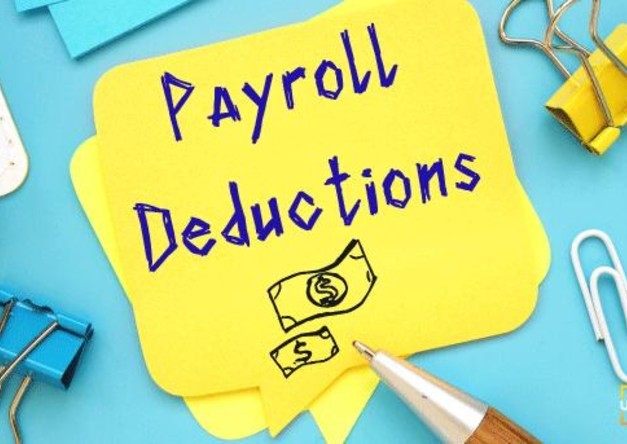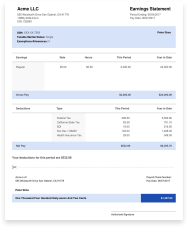Payroll Deductions Explained: Understanding Your Paycheck
By Davis Clarkson , April 6 2025

A good payroll process is needed for any organization. Therefore, understanding payroll deductions is an essential aspect of payroll management. All employees usually pay taxes, so they need to know how their money is deducted.
In this article, we have all your questions regarding payroll deductions explained. We’ll help you understand how it works, why it is necessary and what the types of payroll deductions are. You'll also learn about what a payroll deduction plan means.
Payroll Deductions Explained and How It Works
A payroll deduction refers to the portion of an employee's withheld earnings. It includes deductions for employee taxes, benefits or contributions. An employee's deduction serves many purposes, and it usually comes from their earnings. It can be from their salary, commissions, bonuses, or even work allowances.
Employee payroll deductions are typically made after every pay period. These deductions follow the tax laws and the withholding details given to employees. The deductions from your gross earnings depend on various requirements. It depends on your Form W-4, state or local withholding certificate, and chosen benefits. You'll also consider any legal obligations or wage garnishments that you are required to pay.
Also, where you work affects your deductions because of state pay stub requirements. Employers should check the requirements and apply them to their employee deductions.
While you can calculate employee deductions, there are payroll software that do this and make it easier. These software programs help reduce mistakes and make sure payments are on time.
Types of Payroll Deductions
Payroll deductions are either mandatory or voluntary. Here are the types of payroll deductions. They include required deductions and ones employees can choose.
Mandatory Payroll Deductions
Mandatory deductions are one of the types of payroll deductions. They are deductions that an employee must pay. This is because they must follow laws that mandate that employees pay them. If they fail to do so, it can lead to consequences like penalties or legal issues.
Mandatory types of payroll deductions include:
-
Federal Income Tax: This is the federal tax taken from an employee's pay. Your federal income tax as an employee is based on your gross earnings. This information comes from your W-4. It also depends on how many dependents you have.
Employers must withhold federal income taxes from employees' wages. Federal tax brackets also determine federal income tax, which contributes to what you owe in annual federal taxes. The government uses these taxes to support different services and programs.
-
FICA Taxes: FICA is one of the types of payroll deductions. It is a federal payroll tax that includes Social Security and Medicare contributions. Employers usually calculate them at fixed rates. This means that the Social Security tax is 6.2% of employee wages, while Medicare is 1.45%.
High-income employees may have to pay additional Medicare tax. Employers must withhold at least 7.65% of their employee's wages to meet FICA requirements.
-
State and Local Taxes: Depending on your state, you may also need to deduct state or local income taxes. In some states, employees don't have to pay income tax. However, there are states where it is required. In states requiring an income tax, you must pay it every pay period.
The amount you pay for the taxes withheld depends on how much you earn and your state. Also, not all employees pay local taxes, but if you are required to, make sure you pay.
-
Court-Ordered Deductions: These refer to the deductions that are legally obligated. They are payments that the court mandates you to pay. When a court issues this, employers must take the amount from the employee's paycheck. They will then send it to the designated agency or individual.
Voluntary Payroll Deductions
These payroll deductions are different from mandatory deductions. Employees don't have to pay for them. It depends on the benefits that an employer offers and what employees decide to do. Employers should only deduct these if their employee authorizes them to.
Voluntary deductions include pre-tax and post-tax deductions. Pre-tax refers to the deductions that come in before employee taxes are calculated. Post-tax are those that are taken out after taxes. You'll need to understand them properly because it is important for processing accurate payrolls.
Voluntary pre-tax and post-tax deductions include:
-
Health Insurance: Some employees choose insurance benefits like health and dental insurance. So, their employer will deduct the premiums directly from their paycheck.
-
Wage Garnishments: This applies when an employee has unpaid debts or even child support that they have to pay. An employer can deduct a certain amount of the employee's post-taxes. The amount and duration of this garnishment are usually outlined.
-
Retirement Contributions: Employees can contribute to their retirement accounts, such as a 401(k). They are usually deducted before taxes. They help employees to build their retirement savings.
-
Health Savings Accounts (HSAs) and Flexible Spending Accounts (FSAs): Employees can choose to put some of their earnings into these accounts. These funds can be used for their medical expenses.
-
Additional Insurance: This includes life or disability insurance coverage. Extra premiums are taken from pay before or after taxes, which is based on the policy.
How To Calculate Payroll Deductions
This section outlines the calculation of payroll deductions explained. You simply have to determine your net pay. Follow these steps to correctly calculate your payroll deductions:
-
Apply Pre-Tax Deductions
First, subtract any pre-tax contributions from your gross pay. This includes health insurance, retirement contributions, such as a 401(k), and other voluntary benefits.
-
Determine Federal Income Tax
Use the information on the employee's W-4 form and the current year's IRS tax brackets to determine the federal income tax withheld.
-
Calculate Social Security and Medicare Taxes
To do this, deduct 7.65% from the adjusted gross pay. If needed, also include additional medicare tax. This applies if you are a high-income employee or if you earn above $200,000 in a year. Add an extra 0.9% Medicare tax on your income.
-
Deduct State Income Tax
If you work in states that have an income tax, make sure to withhold it.
-
Subtract Post-Tax Deductions
Lastly, subtract any required post-tax deductions. This can be wage garnishments, Roth IRA contributions, or other obligations to determine employee net pay. It is the final amount you take home.
What Does a Payroll Deduction Plan Mean?
A payroll deduction plan is a plan where an employer regularly takes out an amount of an employee's paycheck. It is usually used to cover employee benefits or savings. A payroll deduction plan helps employees easily manage ongoing payments or investments. It is an automatic and simple plan.
An employee can put some of their earnings into an individual retirement account. Others may have their insurance premiums deducted directly from their paycheck. This is a great way of helping you stay up to date on payments that you have to make.
Effective Payroll Deduction Practices
Consider the following if you want smooth payroll deductions:
-
Make sure you enter the correct payroll info. Double-check it to avoid mistakes with tax deductions.
-
Invest in reliable payroll software to simplify the whole process.
-
Keep up with any changes in taxes or legal requirements to stay compliant.
-
Understand common payroll deduction terms to make it easier.
In Summary
Payroll deductions help both employers and employees. For employees, payroll deductions help with managing finances. You know how much your actual take-home pay is. This helps you budget properly and track your finances. On the other hand, employers can ensure that all required tax withholdings are handled correctly. It is then easier to maintain accurate payroll records. This is very helpful, especially when auditing or preparing tax filings.
Our pay stub tool is exactly what you need for effective payroll practices. It is reliable, helping you simplify every process. It calculates all deductions and provides accurate payroll for employees. You'll then be able to properly manage business practices effectively. Why not get started with us today?
Similar Articles
We’ve helped numerous individuals and businesses create professional documents! Create yours today!










